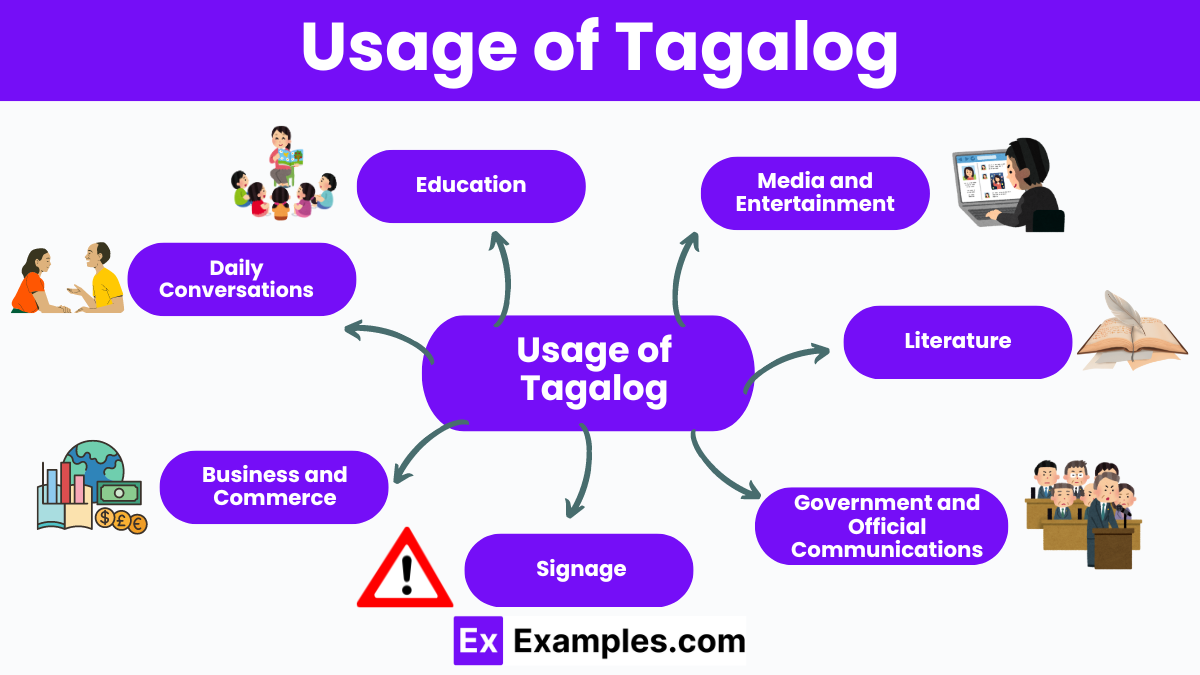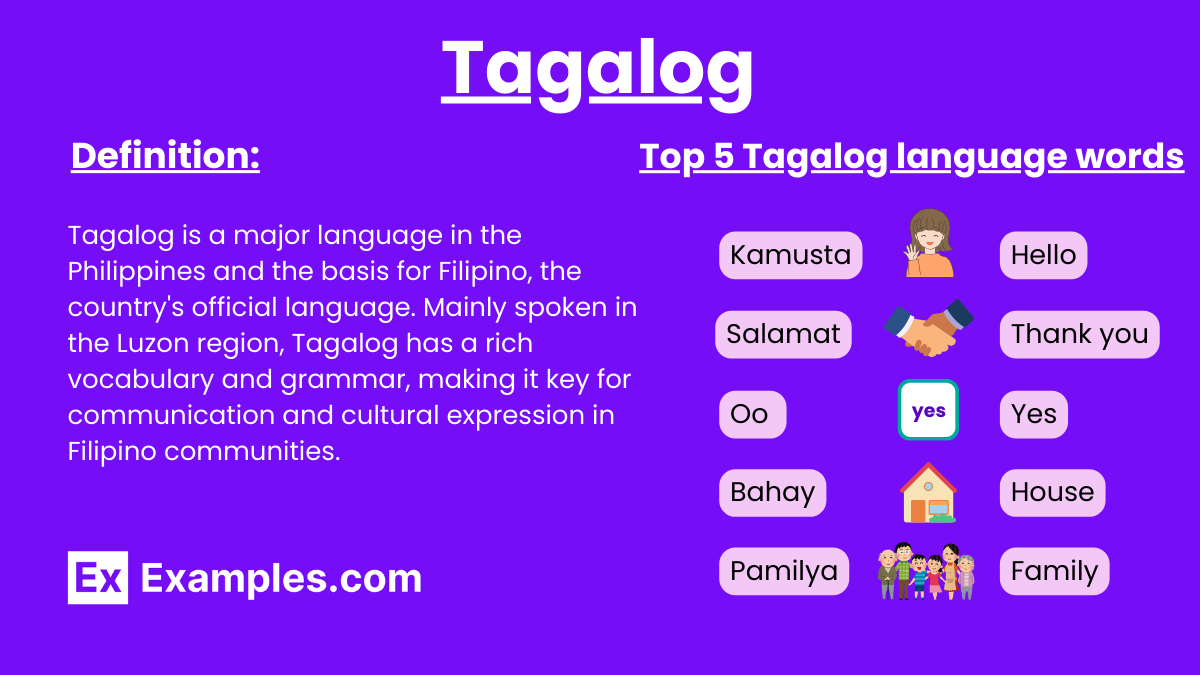50+ Tagalog Examples
Tagalog, a major language of the Philippines, serves as the basis for Filipino, the nation’s official language. Predominantly spoken in the Luzon region, Tagalog is known for its rich vocabulary and grammar, making it essential for communication and cultural expression in Filipino communities.
What is Tagalog?
Origin of Tagalog
Pre-Colonial Era
Before the arrival of the Spanish in the 16th century, the Philippines was already a melting pot of various cultures and Body languages. Tagalog was predominantly spoken in the central and southern regions of Luzon, including the area around present-day Manila. The language was used for trade, communication, and cultural exchange among various ethnic groups.
Spanish Colonization
Spanish colonization began in 1565 and lasted for more than three centuries. During this period, the Spanish had a significant impact on the Tagalog language. Many Spanish words were incorporated into Tagalog vocabulary, especially in areas related to religion, government, and everyday life. The influence of Spanish is evident in words like “mesa” (table), “silya” (chair), and “eskwela” (school).
American Period
After the Spanish-American War, the Philippines became a colony of the United States in 1898. The American influence introduced English into the Philippine education system and daily life. As a result, many English words also found their way into Tagalog. However, Tagalog continued to evolve and maintain its unique identity.
Tagalog language words
- Kamusta – Hello
- Oo – Yes
- Salamat – Thank you
- Bahay – House
- Pamilya – Family
- Kain – Eat
- Inom – Drink
- Maganda – Beautiful
- Malaki – Big
- Maliit – Small
- Dalawa – Two
- Tatlo – Three
- Apat – Four
- Kanin – Rice
- Ulam – Main dish
- Kape – Coffee
- Telepono – Telephone
- Upuan – Chair
- Takbo – Run
- Kain – Eat
Examples of Tagalog in sentences
- Kamusta ka?: How are you?
- Ako si Maria: I am Maria.
- Salamat sa Tulong mo: Thank you for your help.
- Magandang Umaga!: Good morning!
- Pakiusap, pumasok ka: Please come in.
Tagalog examples for students
- May Pasok kami Bukas: We have classes tomorrow.
- Pakiusap, Pakiulit ng Tanong: Please repeat the question.
- Gusto Kong Matutunan ang Agham: I want to learn science.
- Ang paborito kong asignatura ay matematika: My favorite subject is mathematics.
- Kailangan ko ng Bagong Libro para sa Klase: I need a new book for class.
Tagalog examples funny
- Buti pa ang itlog, may itlog ako: It’s good to be an egg; at least I have an egg.
- Nawawala ang kanin ko, baka kinain ng multo: My rice is missing; maybe a ghost ate it.
- Akala ko’y pogi ako, yun pala, nagbibiro lang ang salamin: I thought I was handsome, but it turns out the mirror was just joking.
- Kapag umulan ng tsokolate, siguro ubos na ako: If it rains chocolate, I’ll probably be gone.
- Parang wifi signal ang crush ko, mahina pag malayo: My crush is like a wifi signal, weak when far away.
Types of Tagalog
Standard Tagalog: This is the standardized form of Tagalog used in formal writing and education. It is based on the dialect spoken in Manila and its surrounding areas.
Colloquial Tagalog: This is the everyday spoken form of Tagalog, often mixed with English and Spanish loanwords. It is less formal and used in casual conversations.
Regional Dialects: Tagalog has several regional dialects that vary slightly in vocabulary, pronunciation, and usage. Some of these include:
- Batangas Tagalog: Known for its distinct accent and some unique vocabulary.
- Laguna Tagalog: Has subtle differences from the standard Tagalog.
- Rizal Tagalog: Influenced by its proximity to Manila but still has some unique features.
- Quezon Tagalog: Has variations due to geographical differences within the province.
Manila Tagalog: This is the urbanized version of Tagalog spoken in the capital city, Manila. It is heavily influenced by Spanish and English due to historical colonization and modern globalization.
Classical Tagalog: This refers to the older form of the language used in literature, historical texts, and traditional songs. It contains many words and expressions that are no longer commonly used.
Jejemon Language: A playful, stylized form of writing Tagalog that emerged in texting and online communication, characterized by elongated words, mixed cases, and unconventional spelling.
Taglish: A blend of Tagalog and English, where speakers mix both languages within sentences. This is common in urban areas and among younger generations.
Filipino: Although not a variation of Tagalog, Filipino is the national language of the Philippines and is based on Tagalog. It incorporates words from various Philippine languages and dialects, as well as foreign languages.
Tagalog vs Filipino
| Aspect | Tagalog | Filipino |
|---|---|---|
| Scope | Regional language | National language |
| Vocabulary | Primarily native Tagalog words | Incorporates words from various Philippine and foreign languages |
| Standardization | More rigid and traditional | More flexible and inclusive of modern terms |
| Cultural Influence | Traditional cultural references and idioms | Broader range of cultural references and idioms |
| Loanwords | Fewer loanwords | Includes many loanwords from Spanish, English, and other languages |
| Dialects | Specific to Tagalog-speaking regions | Incorporates elements from various Philippine dialects and languages |
Usage of Tagalog

Daily Conversations:
Example: “Kumusta ka?” (How are you?)
Education:
Example: “Basahin ang aklat sa Tagalog.” (Read the book in Tagalog.)
Media and Entertainment:
Example: “Panoorin natin ang pelikulang ito.” (Let’s watch this movie.)
Literature:
Example: “Nabasa mo na ba ang nobela ni Rizal?” (Have you read Rizal’s novel?)
Government and Official Communications:
Example: “Sumunod sa mga alituntunin ng pamahalaan.” (Follow the government’s rules.)
Signage:
Example: “Bawal pumarada dito.” (No parking here.)
Business and Commerce:
Example: “Magkano po ito?” (How much is this?)
Tips For Tagalog
Practice Daily: Consistency is key. Practice speaking, reading, and writing in Tagalog every day.
Use Language Apps: Apps like Duolingo, Babbel, and Rosetta Stone offer interactive Tagalog lessons.
Watch Filipino Media: Watch Tagalog movies, TV shows, and listen to Filipino music to improve your comprehension and pronunciation.
Join Language Groups: Engage with native speakers through language exchange groups or online forums.
Label Household Items: Label items around your home in Tagalog to immerse yourself in the language.
How to learn Tagalog
Set Clear Goals
- Determine why you want to learn Tagalog (e.g., travel, cultural understanding, communication with friends or family).
Start with Basics
- Alphabet and Pronunciation: Familiarize yourself with the Tagalog alphabet and pronunciation.
- Basic Vocabulary: Learn common words and phrases such as greetings, numbers, and essential nouns and verbs.
Use Language Learning Apps
- Duolingo: Offers beginner courses in Tagalog.
- Babbel: Provides structured lessons on vocabulary and grammar.
- Memrise: Focuses on building a large vocabulary through spaced repetition.
Take Online Courses
- Udemy: Offers comprehensive courses in Tagalog for all levels.
- Pimsleur: Audio-based learning focused on conversational skills.
- Coursera: May have courses on Filipino language and culture.
Practice with Native Speakers
- Language Exchange Apps: Apps like Tandem and HelloTalk connect you with native Tagalog speakers.
Are there cultural aspects to consider when learning Tagalog?
Understanding Filipino culture, customs, and etiquette can greatly enhance your language learning experience and help you communicate more effectively.
Can I use English while learning Tagalog in the Philippines?
Yes, English is widely spoken in the Philippines, especially in urban areas and among educated Filipinos. Using English can help you navigate while you continue learning Tagalog.
How long does it take to learn Tagalog?
The time it takes to learn Tagalog depends on the learner’s dedication, study methods, and prior language learning experience. Consistent practice over several months to a few years is typically required to achieve proficiency.
Is Tagalog spoken outside the Philippines?
Tagalog is primarily spoken in the Philippines, but there are communities of Tagalog speakers in countries with significant Filipino populations, such as the United States, Canada, and Saudi Arabia.
Can I learn Tagalog online?
Yes, there are many online resources, including websites, apps, and courses that offer comprehensive Tagalog language learning.
How is Tagalog grammar different from English grammar?
Tagalog grammar is more complex, with a focus on verb conjugation and affixation to indicate tense, aspect, and mood. Sentence structure often follows a Verb-Subject-Object (VSO) order.
Are there any dialects of Tagalog?
Yes, there are various dialects of Tagalog spoken in different regions. The standard form of Tagalog, used in education and media, is based on the dialect spoken in Manila and nearby provinces.
What alphabet does Tagalog use?
Tagalog uses the Latin alphabet, consisting of 28 letters, including the basic 26 letters of the English alphabet plus “Ñ” and “Ng.”
Is Tagalog difficult to learn?
The difficulty of learning Tagalog depends on your native language and your previous language learning experience. For English speakers, Tagalog can be challenging due to its unique grammar and vocabulary.
How is Tagalog different from Filipino?
Tagalog is a regional language, while Filipino is the national language that incorporates elements from Tagalog and other Philippine languages, as well as foreign languages.



